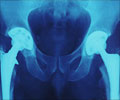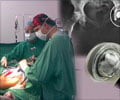Engineers at the University of Bath have developed a diagnostic test to detect loosened artificial hip implants. In basic, this works by measuring the frequency
Engineers at the University of Bath have developed a diagnostic test to detect loosened artificial hip implants. In basic, this works by measuring the frequency of sound produced when the femur bone in the leg is vibrated.
The new method is much more sensitive than the traditional method of using x-rays to detect the loosening of implants, and so can diagnose much smaller gaps around the implanted joint.Around 50,000 people receive total hip replacements in the UK each year, and many will go on to develop pain from them. It is estimated that within 10 years of having an implant, about a quarter of patients will suffer pain from a loosening of the joint, which are joined to their leg bone by a special cement.
Surgeons find it difficult to know whether this from an infection, which can be cured by antibiotics, or because the joint has loosened, which means surgery is needed. A reliable diagnostic test is vital to save patients undergoing unnecessary surgery.
Dr James Cunningham, of the University of Bath’s Department of Mechanical Engineering, has developed the method of placing a piece of vibrating equipment on to the patient’s knee, which vibrates the femur and the hip joint.
An ultrasound device is attached to the hip and this picks up sound vibrations from the vibrating joint. If the sound’s frequencies are ‘pure’ – a regular wave of increasing and decreasing frequencies - then they know the joint is firmly fastened to the bone. If the sound waves are impure and irregular then they know that the joint has come loose.
“This finding is important because surgeons need to know if the pain the patient is feeling comes from a loose joint needing surgery, or from another cause,” said Dr Cunningham.
Advertisement
Source-Eurekalert
LIN/B










